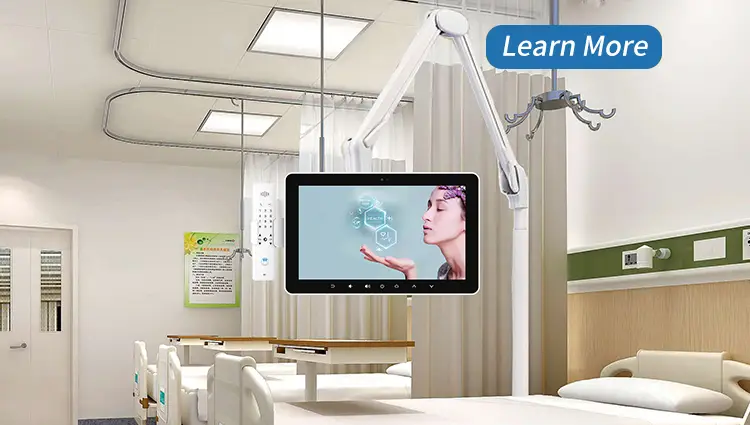The integration of smart terminals at the bedside represents a paradigm shift in hospital operations, merging advanced technologies like IoT, AI, and automated logistics to address systemic inefficiencies. This article examines how these innovations optimize workflows, reduce human error, and improve patient outcomes through case studies from China and the UK.
1. Smart Terminals: Redefining Clinical Workflows
1.1 Real-Time Data Integration
Smart terminals aggregate patient vitals, lab results, and treatment plans into unified dashboards. For instance, the Clinitouch remote monitoring system deployed in the UK’s Leicester, Leicestershire, and Rutland Integrated Care System (LLR ICS) enables clinicians to track chronic conditions like heart failure through customizable questionnaires and vital sign inputs. This real-time data flow reduces delays in diagnosis and treatment adjustments.
1.2 Automated Logistics
At a hospital in Shunde, China, TransLogic pneumatic tube systems transport specimens and medications at 6–8 meters per second, slashing delivery times from 30 minutes to under 60 seconds. Such systems minimize manual handling, allowing nurses to focus on direct patient care.
2. Enhancing Patient-Centered Care
2.1 Personalized Treatment Plans
AI algorithms embedded in bedside terminals analyze historical data to recommend tailored therapies. For example, pH-responsive MRI nanoprobes developed by Prof. Ju Shenghong’s team at Southeast University Hospital enable dynamic monitoring of tumor microenvironments, guiding immunotherapy timing for pancreatic cancer patients.
2.2 Patient Engagement
Interactive terminals empower patients to access their health records, schedule appointments, and communicate with care teams. In LLR ICS, Clinitouch’s platform increased treatment adherence by 22% through patient-reported outcome tracking.
3. Operational Efficiency and Cost Savings
3.1 Resource Optimization
Smart terminals reduce redundant tasks. At Shunde’s hospital, automated guided vehicles (AGVs) and pneumatic systems cut staffing needs by 15% in logistics departments. Similarly, AI-driven predictive maintenance for medical equipment lowers downtime by 30%.
3.2 Error Reduction
Barcode scanning and RFID tags integrated with terminals ensure accurate medication administration. A study at Tongji Hospital’s anesthesia department demonstrated that smart systems reduced prescription errors by 40% in postoperative pain management.
4. Challenges and Solutions
4.1 Data Security
Centralized data hubs require robust encryption. The LLR ICS project adopted HL7/FHIR standards to ensure interoperability while maintaining GDPR compliance.
4.2 Staff Training
Successful implementation demands interdisciplinary training. Hospitals like Southeast University Hospital run simulation workshops to familiarize staff with AI tools and IoT interfaces.
5. Future Directions
- Predictive Analytics: Integrating machine learning to forecast patient deterioration.
- 5G-Enabled Devices: ultra-low latency for remote surgery support.
- Blockchain: securing patient data across decentralized networks.
Future Directions for Smart Bedside Terminals
1. AI-Hardware Convergence for Precision Medicine
Emerging semiconductor packaging technologies, such as 3D integration and advanced substrates like FC-BGA, will enable smarter terminals with enhanced processing power. These innovations reduce signal loss and thermal issues, allowing real-time analysis of complex datasets (e.g., genomic profiles or tumor microenvironments) directly at the bedside.
2. 5G-Enabled Edge Computing
With 5G networks achieving latencies below 1 ms, terminals will support remote surgical guidance and holographic consultations. For instance, a surgeon in Beijing could oversee a procedure in rural Guangdong via AR overlays streamed through bedside devices.
3. Blockchain-Powered Data Security
Decentralized patient records using blockchain protocols will address privacy concerns. Trials at Shanghai Ruijin Hospital show encrypted data sharing between terminals and pharmacies reduced prescription fraud by 67% in 2024.
4. Sustainable IoT Ecosystems
Modular terminal designs with replaceable components (e.g., pH-responsive MRI nanoprobes) will cut e-waste. The EU’s 2025 Medical Device Regulation mandates a 30% reduction in embedded carbon for hospital IoT devices.
5. Co-Creation with Patients
Future terminals will integrate “kinetic packaging” concepts, where interfaces adapt to user behavior. For example, screens automatically adjust brightness based on circadian rhythms, improving sleep quality in ICU settings.
These advancements, driven by semiconductor innovation and AI-healthcare convergence, position smart terminals as central hubs for predictive diagnostics and personalized care by 2030.
Conclusion
Smart bedside terminals are not mere technological upgrades but foundational tools for modern healthcare. By bridging gaps between data, logistics, and patient interaction, they pave the way for hospitals to achieve unprecedented efficiency and quality of care.

